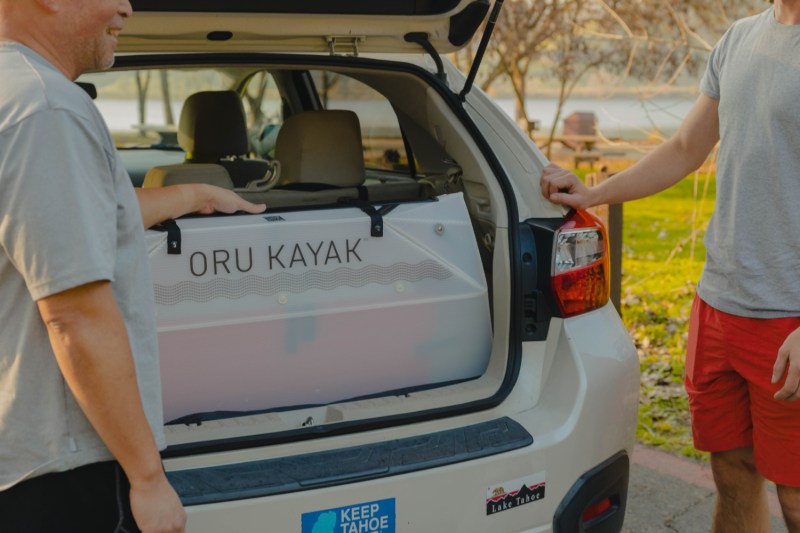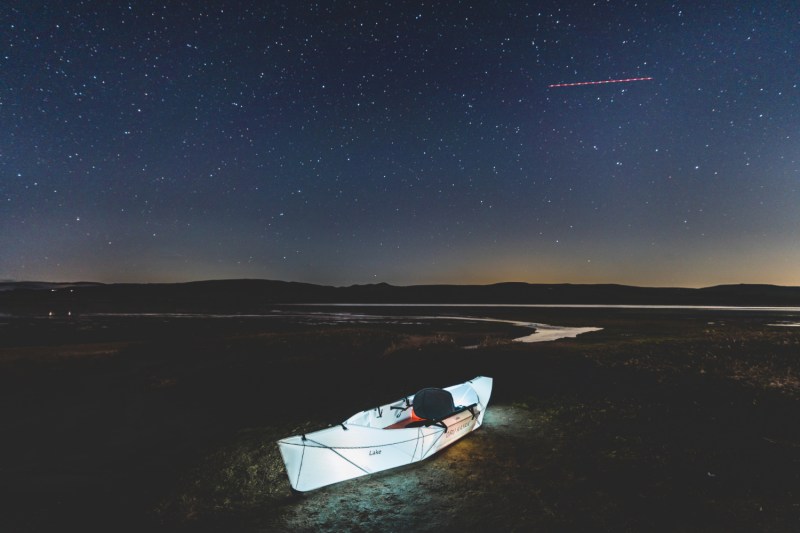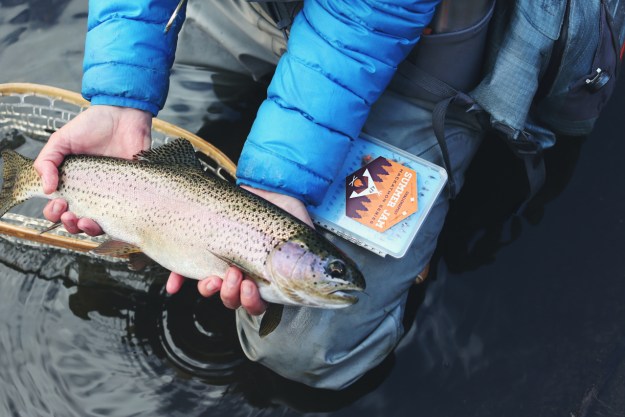The Oru Lake kayak may look like a wonder of modern technology, but truth be told, there’s nothing modern about it. Oru kayaks are about as simple and straightforward as they come, and their ingenious designs come straight from the 1,000-year-old Japanese tradition of origami (which was likely borrowed from the even older Chinese tradition of Zhezhi, dating back some 1,800 years). So yeah, these boats may not be modern, but they’re certainly a wonder.
Such a wonder, in fact, that when the folks at Oru were kind enough to send me a test sample, I couldn’t take it anywhere without at least one person walking up and asking about it.
“Is that one of those folding boats?” they asked.
“Why, yes, yes it is,” I replied as I was literally unfolding the boat.
“How much does that thing weigh?” they asked.
“Not much,” I replied as I effortlessly lifted it with one hand and plopped it down in the water.
“I heard those things are expensive,” they said.
“Not this one,” I replied as I launched the boat into the river and started paddling away.
Perhaps the most wondrous part about this whole experience was that the above exchange all took place in about a minute. That’s how fast the Lake goes from “suitcase mode” to “ready to paddle” — and yes, anyone can do it just as quickly. You’ve probably got a few questions of your own about the Oru Lake, so let me tell you what I know after spending the last two months with one.

What Is the Oru Lake Kayak?
The Oru Lake is a 9-foot recreational kayak made almost entirely from double-layer extruded polypropylene. Like Oru’s other products, it converts from a full-sized boat into a trunk-friendly suitcase with a few simple folds, but this is the company’s most compact and user-friendly model to date.
It’s also their lightest model to date, and at just 18 pounds, it also happens to be the lightest rigid kayak on the market. For anyone who has ever had the pleasure of lugging a rigid kayak around solo, that’s roughly half the heft of comparable rotomolded boats. The entire craft consists of just two parts — the boat itself and the folding clamshell seat, which also doubles as a rigid plate supporting the Lake’s flat-bottom shape.
How Does It Work?
Oru Lake Foldable Kayak
The Oru Lake’s secret sauce is that double-layer polypropylene material we mentioned above, which is essentially a beefed-up (5mm-thick) version of the same indestructible stuff the United States Postal Service uses for hauling around your mail. Oru claims this special plastic is tough enough to handle the rigors of regular use — sliding across rocky river bottoms, for example — yet pliable enough to be folded and unfolded tens of thousands of times without splitting.
When unfolded and locked into place using the Lake’s attached tension straps, this material transforms a foldable sheet of plastic into a rigid craft that’s still buoyant enough to support up to 250 pounds of paddler and gear (or in my case, paddler and pup). There’s enough space left over inside for a dry bag or two, whether that’s behind the seat or between your legs.

Standout Features of the Oru Lake
- Impressively light at just 18 pounds
- Fits together in under a minute
- Most affordable boat in the Oru lineup
- Packs down into the trunk of your car
- Looks pretty darn cool
What I Like About the Oru Lake Kayak
It takes the hassle out of casual kayaking: I love a day out on the water as much as the next person, but I genuinely hate hauling around the weight and bulk of a standard rotomolded kayak. This is essentially a hardshell kayak that you can easily throw into your trunk. I can toss two of these in the bed of my truck and still have plenty of room left over for a full weekend’s worth of camping gear, no roof rack required. Convenience alone is a strong argument for this boat.
It’s a unique experience: Aside from the paddling itself, everything about using an Oru feels genuinely unique. The semi-transparent plastic allows light to filter through the body, so you get this cool experience of having shimmering water all around you as you paddle. You can also throw a few lights inside the Oru for late evening sessions, and it feels something like floating around inside a paper lantern.
It doesn’t take up space around the house: If you live in an apartment or a small home without a garage, storing a solid 9-foot watercraft is pretty much out of the question. Anyone can stash two of these boats in a hallway closet. No giant boat rack required. No hanging them from the ceiling. No issue walking one through your front door.

What I Don’t Like
It’s limited to casual use: The Lake is a great option for still water or slow-moving rivers, but it’s not intended to do much else. Limited weight capacity and storage mean it’s not built for overweight trips. It’s definitely not intended to take on rapids, and you’d have to get pretty creative to be able to take it fishing.
It’s still a little pricey: The Lake’s Kickstarter price was a real bargain at $499, but if you missed that window, you missed that price. You can still put in a pre-order at a reduced $550 (deliveries are expected in September this year), but once the Lake hits production, the planned MSRP goes up to $700. That’s going to be a tough pill to swallow for casual users who really don’t need much more than a simple inflatable kayak, although admittedly, the Oru is miles ahead of cheap inflatables in terms of quality and design.

FAQs for the Oru Lake
How durable is the Oru Lake?
Oru claims the Lake’s double-layered plastic body is built to survive approximately 20,000 folds. By that logic, if you unfolded and refolded the boat every single day of the year, the Lake would last over 27 years. Of course, that math assumes daily use and proper care (like not dragging your boat across the parking lot), so it’s tough to say for sure. I’d wager that the lifespan of the Lake depends more on the hardware — namely the straps and buckles — but it seems ready and willing to serve your average paddler for several years of regular use.
Are folding kayaks worth the money?
The main selling point of any Oru kayak is its compact size, which makes it an attractive alternative to an inflatable kayak. I’ve used both and can enthusiastically recommend the Oru over any inflatable I’ve tried. It sets up and packs down much faster, handles about the same, and doesn’t give you that terrible “sitting inside a rubber sock” feeling that inflatables do. Keep in mind that the Lake’s size and shape — and lack of a rudder — don’t make it the straightest-tracking boat in the world, but if a fun casual paddler is what you’re after, it’s worth considering.

Should You Buy an Oru Lake Kayak?
Ultimately, the decision to buy the Oru Lake over something else comes down to three things: Quality, portability, and design. If you don’t have the means or desire to store a full-sized boat at home, the Lake is a particularly sweet alternative to an inflatable, and it’s much easier to transport and store than a typical rigid boat. Inflating and deflating a kayak is always a pain, whereas this portable is ready to go swimming in under a minute. Personally, I’d pick the Lake’s double-wall plastic over the more puncture-prone PVC walls of an inflatable any day if I had the funds. It also looks much cooler and runs much cooler on a hot summer day. If all of those perks sound like selling points to you, the Lake will be a smart buy.
Editors' Recommendations
- Visitors to Death Valley have rare opportunity to go kayaking in an ancient lake (for a limited time)
- Take to the water this summer with the best compact, ultra-portable folding kayaks
- The Best Places to Explore the Great Outdoors of Lake Tahoe
- Oru’s Origami-Inspired Inlet Kayak Will Be the World’s Most Portable Watercraft




